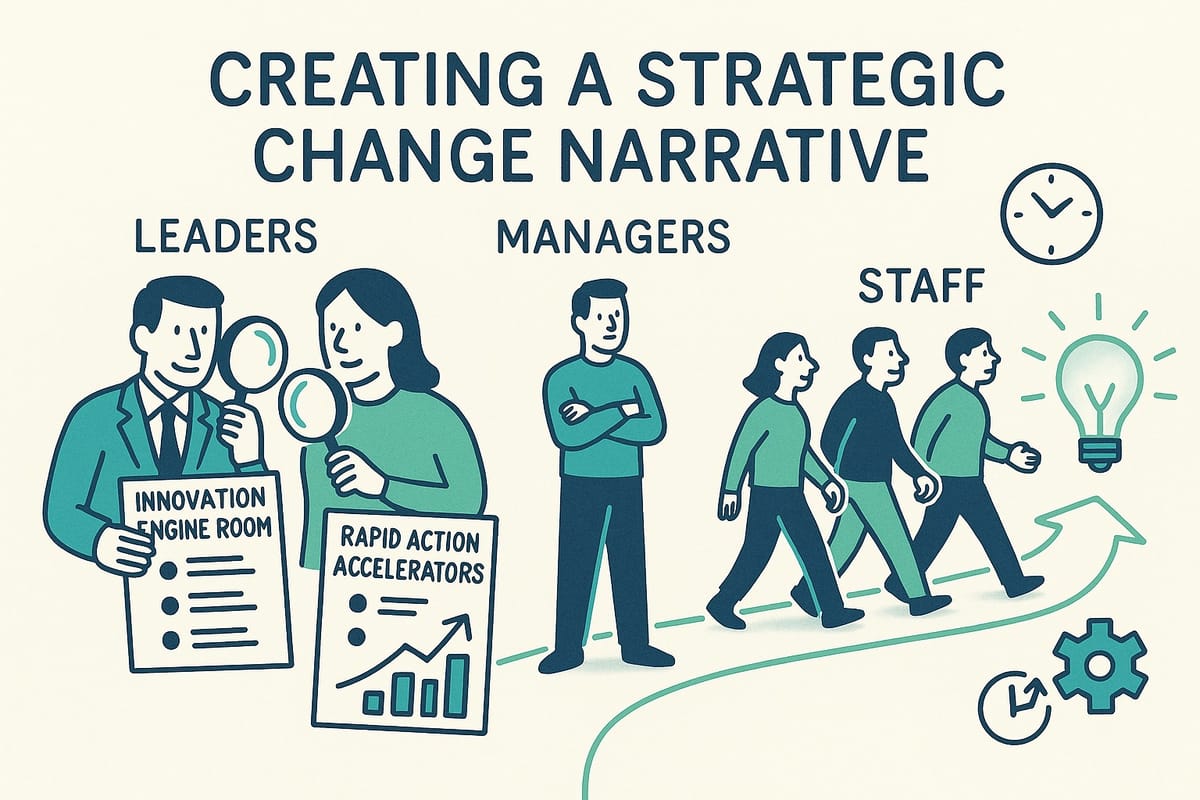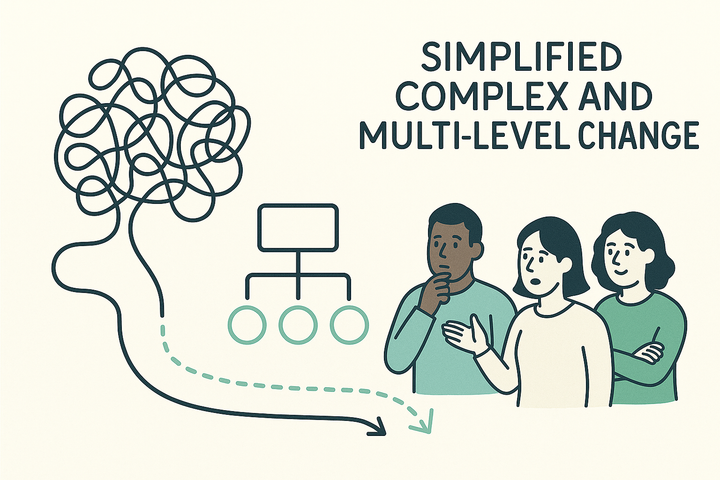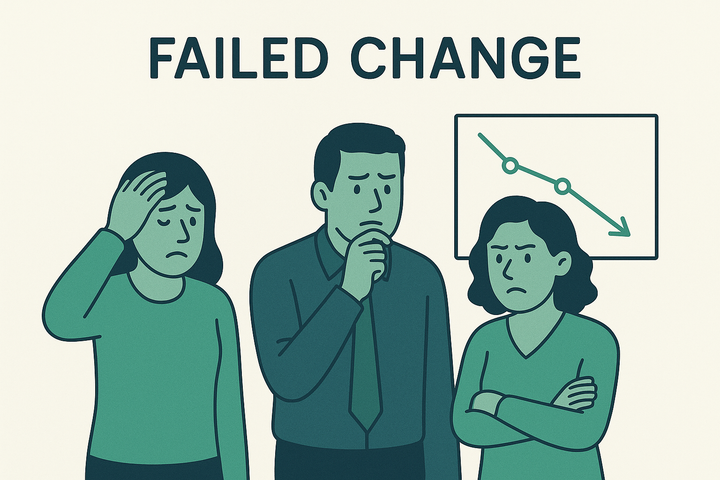Creating a Change Narrative
Most change communications fall flat because they’re trying to deliver a message without a story. This article shows how to create a strategic change narrative that helps people understand, believe and act.

Why narrative matters
If you work in change, you already know how messy it gets.
Multiple stakeholders. Conflicting priorities. Unclear timelines. Shifting scope. Everyone is working flat out, but no one is quite sure if it’s landing.
In the middle of all this sits communication. Often squeezed in too late. Often tasked with "getting the message out" without being properly involved in what’s actually happening.
But here’s the truth: messages without a narrative are just noise.
People don’t engage with strategy slides. They engage with stories. And in the context of change, that means building a clear, cohesive and credible strategic change narrative.
It’s the thread that holds the work together. The story that helps people make sense of what's happening, see where they fit, and act with intention.
What is a strategic change narrative?
A strategic change narrative is not a set of talking points. It is not a three-word slogan. It is not your programme’s visual identity.
It is the underlying story that explains:
- What’s changing
- Why it matters
- What success looks like
- How we’ll get there
- What it means for different people
- What you want them to do next
It should feel grounded, human and coherent. It should help people move from confusion to clarity, and from understanding to action.
Why most organisations skip it
Three reasons:
1. They mistake messaging for narrative
Messaging is important, but without a story behind it, it lacks meaning. You end up with comms that sound polished but land flat.
2. They try to align before they’ve made sense of the story themselves
You can’t align your leadership team around a message they don’t fully believe or understand. Lack of alignment fractures narrative coherence.
3. They rush to broadcast
Under pressure to “get the comms out,” teams often default to tactics — the email, the deck, the intranet page — before they’ve agreed the story that holds it all together.
What a good narrative does
A good strategic change narrative does three jobs:
It creates shared understanding
It helps people make sense of what's happening and why. It answers the burning questions before they become whispered rumours.
It builds belief
It offers a compelling reason to care. Not just in organisational terms, but human ones. It taps into values, meaning and purpose.
It moves people to act
It turns clarity into momentum. A good narrative doesn't just explain. It invites. It encourages. It mobilised.
You might also like:
- Creating a Change Narrative
- Using Metaphors in Change Narratives
- The Art of the Backstitch – Why You Need to Return and Return Again to Your Narrative
- Change and Transformation Visions – Painting the Future State
- The Four Types of Organisational Change and How to Communicate Them
The structure of a strategic change narrative
There’s no one-size-fits-all, but here’s a structure that works for most organisations navigating complex change:
1. The context (also called the current state)
What’s the environment we’re operating in? What’s shifted? What are we responding to?
This isn’t about justifying a decision. It’s about creating a shared picture of reality. Include external drivers (market shifts, legislation, global events) and internal ones (performance, culture, risk).
2. The case for change (or the burning platform)
Why now? What’s not working or no longer fit for purpose? Where are the opportunities? What happens if we do nothing?
This is where you frame urgency and relevance. Be specific. Be real. People respond to honesty.
3. The vision (also known as the future state)
What are we moving towards? What does success look like? How will things be better, stronger or more sustainable?
Paint a picture people can see themselves in. This is where belief is built.
4. The pathway (or change journey and alignment pathway)
How are we getting there? What are the phases, principles or priorities guiding us?
This is where you start to translate strategy into shape. Avoid false certainty. Be clear about what’s fixed and what’s still evolving.
5. The impact
What does this mean for people? What will shift in how they work? What benefits — in value, effectiveness or cost savings — can be expected if this lands well?
Here’s where the narrative becomes personal. Anticipate questions, surface implications, and be honest about the effort involved.
6. The ask (or behavioural activation)
What do we need from people now? What behaviours matter most? What will look or feel different?
End with agency. Don’t just inform — activate.
How to build it
Start with leadership
Your leadership team must be part of building the narrative, not just signing it off. If they’re not aligned, the story fragments immediately.
Then onboard, enrol and brief managers
Managers are your internal advocates. They need to be brought in early, given room to question and understand, and then equipped to help translate the narrative for their teams. If they’re not part of the process, they’ll become blockers by default.
Use real language
Avoid jargon, slogans or over-polished corporate speak. If it wouldn’t pass the “pub test” — someone saying it out loud in a conversation — it’s not ready.
Pressure-test it
Run it past people who will poke holes. Try it with a sceptical team. Ask: Does it make sense? Does it feel real? Is anything missing?
Make it modular
You’re not creating a single speech. You’re building a core narrative that can be tailored to different audiences and contexts without losing its spine.
Reinforce it again and again
Narrative isn’t a one-time thing. You’ll need to stitch it through everything — leader updates, team meetings, project decks, reward schemes, values, and onboarding. Keep returning to the thread.
What to watch out for
Lack of narrative discipline
If different leaders are telling different stories, your people will spot it instantly. Stick to the spine. Encourage local flavour, but not contradiction.
Lack of ownership
If senior leaders or managers disown the narrative, by distancing themselves from decisions or framing it as “them, not us”, — trust collapses. Everyone must own the message, even if they didn’t originate it.
Over-promising
Change takes time. Don’t sell certainty you can’t back up. A credible narrative includes doubt, challenge and commitment — not spin.
Tactical comms with no throughline
If every message feels disconnected from the last, it’s a sign the narrative isn’t embedded. Start pulling it through your rhythms and rituals.
Final thought
Change communication isn’t just about what you say. It’s about what people understand, believe and do as a result.
A strategic change narrative helps you get there. It gives people the thread to hold onto when everything else feels like it’s shifting.
Get the story right, and the comms have somewhere to go.
Ready to Craft a Narrative That Actually Lands?
If your change story isn’t landing — or your teams are confused, misaligned or disengaged — it might be time to step back and reframe the narrative. The Sound & Signal Review gives you a clear, honest view of what’s working, what’s missing and where to go next.
Already knee-deep in delivery and need a fast reset? Our Rapid Action Accelerators are designed to cut through noise, align leadership and get the story straight — fast.



